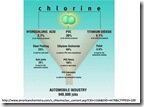 Industry consumed one fifth of energy in the U.S. in 2008. Similar to fossil fuel domination of the transportation and electricity sectors, industrial fuels in 2008 were predominantly petroleum (42%) and natural gas (40%), with renewable energy and coal each comprising <10% of industrial fuels.
Industry consumed one fifth of energy in the U.S. in 2008. Similar to fossil fuel domination of the transportation and electricity sectors, industrial fuels in 2008 were predominantly petroleum (42%) and natural gas (40%), with renewable energy and coal each comprising <10% of industrial fuels.
What constitutes industry? For energy consumption purposes, the EIA characterizes the industrial sector as “all facilities and equipment used for producing, processing, or assembling goods, and encompasses manufacturing, agriculture, forestry, fishing and hunting, mining (including oil and gas extraction), and construction.”
The EIA further notes that “Every industry uses energy, but there are a handful of energy-intensive industries that use the bulk of the energy consumed by the industrial sector.” In 2006, the petroleum refining industry was the largest industrial consumer of energy (32%), followed closely by the chemical industry (24%) and the paper (11%) and metal (8%) industries, with ‘other’ industries using up the rest.
The breakdown above represents a combination of energy used to power machinery in order to harvest or manufacture goods, as well as the use of fuels as ingredients in manufactured goods. When fuels or other raw materials are used as ingredients they are referred to as “feedstocks”. In addition to consuming 75% of total energy used by industry, the top four industries mentioned above also consume 97% of the industry energy feedstock. However, with respect to feedstocks it should also be noted that “less common sources” account for 56% of energy feedstocks and predominantly represent fuels generally thought of as renewable resources such as wood by-products and agricultural waste.
Just as a home audit identifies areas to target for high-yield returns, examining energy consumption among the four greatest user groups within the industrial sector provides valuable insight into lifestyle changes that each of us can make (the “I” in industry) that will have the greatest society-wide benefits.
 1) Petroleum refining (32%). It takes the equivalent of one barrel of petroleum to make three barrels worth of petroleum-based transportation and heating oil fuels; thus, for every 10% reduction in demand for petroleum for transportation and heating, we also save an ‘bonus’ 3.2% in industrial energy consumption.
1) Petroleum refining (32%). It takes the equivalent of one barrel of petroleum to make three barrels worth of petroleum-based transportation and heating oil fuels; thus, for every 10% reduction in demand for petroleum for transportation and heating, we also save an ‘bonus’ 3.2% in industrial energy consumption.
 2) The chemical industry (24%). Whether it’s making a petro-chemical or using energy to extract other naturally occurring chemicals, “Few goods are produced without some input from the chemical industry (EIA).” Energy that is needed to make end products can be described as essential, and represents energy that will need to be provided by renewable energy sources in the future. However, energy used as a raw material or as a fuel to create packaging for those manufactured goods or to transport manufactured goods largely represents non-essential energy, making them good targets for improvement areas. In addition to reducing total consumption of manufactured goods, conscientious efforts to patronize vendors that provide products with limited packaging (and petitioning other manufacturers to follow suite) or that support sustainable packaging are crucial.
2) The chemical industry (24%). Whether it’s making a petro-chemical or using energy to extract other naturally occurring chemicals, “Few goods are produced without some input from the chemical industry (EIA).” Energy that is needed to make end products can be described as essential, and represents energy that will need to be provided by renewable energy sources in the future. However, energy used as a raw material or as a fuel to create packaging for those manufactured goods or to transport manufactured goods largely represents non-essential energy, making them good targets for improvement areas. In addition to reducing total consumption of manufactured goods, conscientious efforts to patronize vendors that provide products with limited packaging (and petitioning other manufacturers to follow suite) or that support sustainable packaging are crucial.
As a consumer, it’s tough to know how much energy was used to manufacturer a particular product versus how much energy was used to manufacturer the packaging for that product. However, an easy rule of thumb is to simply evaluate the amount of packaging that is associated with a product sitting on the shelf relative to the actual product. If you have an opportunity to choose between purchasing a product that by weight or volume looks like it is 75% product and 25% packaging versus 75% packaging and 25% product, support the vendor that used less packaging. In other instances, we receive frivolous packaging in the store in the form of paper or plastic bags, even though re-usable bags represent a much more sensible solution. The Bring Your Own movement must prevail over the disposable society, and is based on simple actions like taking your own re-usable cup to a party or restaurant, or using your own container for leftovers or when purchasing food items whenever it is reasonable to do so. After all, which is less cool: adding to the landfill, or using your own cup in front of your friends?
Although every 10% across the board reduction in energy associated with producing packaging will only curb total U.S. energy consumption by 2.4% (based on 2008 levels), there is also a positive environmental feedback loop to consider. First, consuming less stuff overall will allow renewable energy sources to go further with respect to generating the stuff we do consume. Second, less packaging (regardless of how made) will also result in less packaging being hauled off to the landfill (transportation fuel reduction), being burned in incinerators (less disposal energy and subsequent air/water pollution), or ending up as unsightly and often harmful litter for wildlife. And lastly, we mustn’t forget the relationship between physics and behavior: a conscientious consumer in motion, even if only ever so slightly, continues to stay in motion….whereas the complacent over-consumer at rest also unfortunately remains that way, too.
 3) The Paper Industry (11%): To its credit, the paper industry actually supplies about a quarter of its own energy in the form of wood waste products; however, this industry still represents the third largest U.S. consumer of energy, notably fossil fuel energy. Also known as the “forest products industry”, pulp and paper production account for 84% of the energy used by this industry, with wood product production representing the rest.
3) The Paper Industry (11%): To its credit, the paper industry actually supplies about a quarter of its own energy in the form of wood waste products; however, this industry still represents the third largest U.S. consumer of energy, notably fossil fuel energy. Also known as the “forest products industry”, pulp and paper production account for 84% of the energy used by this industry, with wood product production representing the rest.
Given the extent to which technology is infused in our society, reducing energy associated with pulp and paper production should be relatively easy to achieve. Electronic or online documents reduce the need for mass production of hard copies (though some hard copies should exist for posterity). In fact, for better or worse, the mass consumer movement in the direction of electronic media is already driving a demise in the printing of newspapers and to a lesser extent, magazines. Similar to do not call lists, do not mail lists now allow you to remove yourself from junk mail distribution lists, saving energy associated with paper production as well as transportation fuel when delivering and removing said junk mail from your home or business. Paper and pulp products are also consumed in the form of packaging, notably paperboard and corrugated cardboard; thus, emphasizing the importance of “reduce, re-use, recycle”.
 4) The Metal Industry (8%): Energy consumed by the metal industry occurs at multiple operational levels, but primarily as a result of extracting raw materials from the earth and smelting to remove impurities. Two metals associated with greatest energy usage in the U.S. include aluminum and iron ore used to make steel. Operations to refine these metals have reduced energy consumption by more than 30% since the 1970’s thanks in large part due to recycling of scrap material. For example, according to the EIA it takes 95% less energy to make an aluminum can from a recycled aluminum can than it does to make a new aluminum can from bauxite ore. Unfortunately, these processes remain energy-intensive. Because only 80% of steel and 50-60% of aluminum is currently recycled there is room for further energy reductions through recycling; however, “reduce and reuse” must also be brought into the equation if renewable energy is going to be able to exclusively support metallurgy in the future.
4) The Metal Industry (8%): Energy consumed by the metal industry occurs at multiple operational levels, but primarily as a result of extracting raw materials from the earth and smelting to remove impurities. Two metals associated with greatest energy usage in the U.S. include aluminum and iron ore used to make steel. Operations to refine these metals have reduced energy consumption by more than 30% since the 1970’s thanks in large part due to recycling of scrap material. For example, according to the EIA it takes 95% less energy to make an aluminum can from a recycled aluminum can than it does to make a new aluminum can from bauxite ore. Unfortunately, these processes remain energy-intensive. Because only 80% of steel and 50-60% of aluminum is currently recycled there is room for further energy reductions through recycling; however, “reduce and reuse” must also be brought into the equation if renewable energy is going to be able to exclusively support metallurgy in the future.
Reducing aluminum and steel consumption largely comes down to choices we make regarding food purchases. As consumers, it’s easier to reduce aluminum consumption since more foods (primarily beverages) are packaged in aluminum than steel or tin (which is really tin-plated steel). With respect to aluminum we also generally have choices (glass or plastic bottle, keg); however, the nature of the smaller footprint for alternative packaging largely depends on the extent of recycled material in each container and the distance it had to travel to reach you. As eloquently pointed out by “The Green Lantern”, kegs take top prize as the most eco-friendly container. And of course, re-usable cups for beverages dispensed from the keg add even more icing to the cake!
Back to Energy main page
